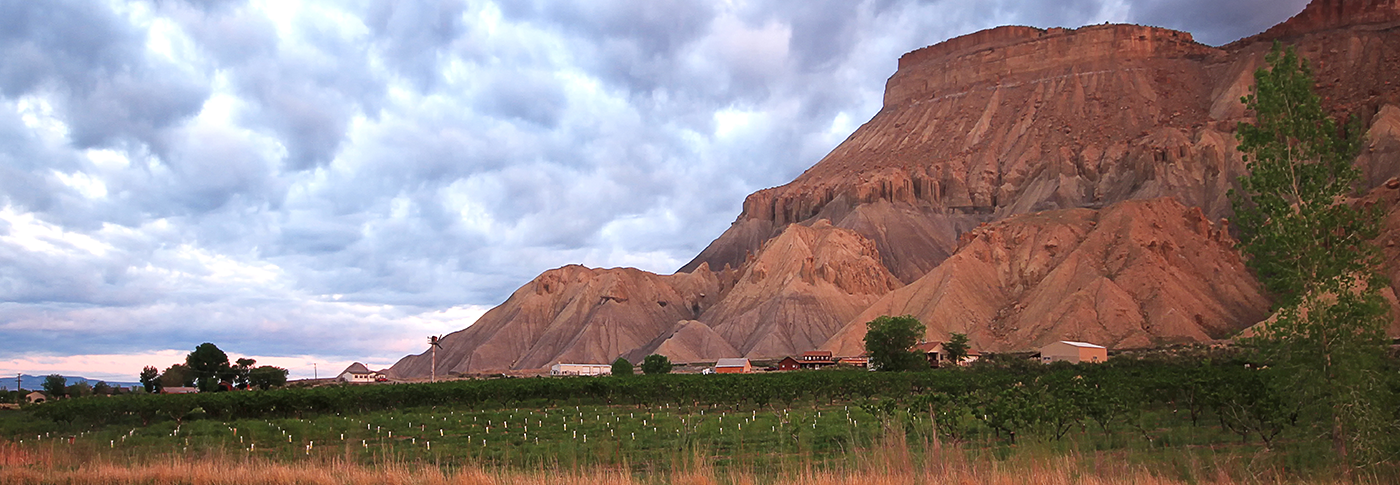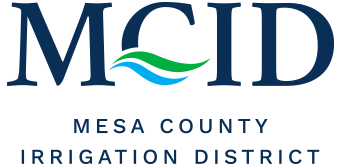About
About Mesa County
Irrigation District
Mesa County Irrigation District receives its water via the Government Highline Canal into its primary canal, the Stubb Ditch. Some of MCID’s water is also delivered directly from the Government Highline Canal.
Our Irrigation Water
The Mesa County Irrigation District delivers irrigation water from the Colorado River to a wide variety of agricultural enterprises in the eastern portion of the Grand Valley of west-central Colorado. Within the District you can find world-acclaimed vineyards and orchards including pear, peach, apricot, cherry, and apple. Hay, corn, alfalfa, vegetable farms, and hops are also grown. The Grand Valley Water Users Association delivers Colorado River water from their Cameo Diversion or “Roller Dam” to the District through the Government Highline Canal. Part of the District’s water right is diverted from the Government Highline Canal as it enters the Grand Valley and flows into the Stub/ Price pumping plant where water is lifted into the Stub Ditch. The Stub Ditch really isn’t a ditch at all anymore. It was converted to a large diameter pipe through the federally funded Salinity Program in the mid-1990’s. Prior to that time, the District’s main responsibility was to simply ensure there was water enough in the Stub Ditch to serve the 100 or so headgates stretching along its 9 plus mile course. This was accomplished by the ditchrider who regularly rode the ditch either by horseback or pickup setting headgates and clearing the ditch from debris.

As part of the Salinity Program, water users were asked if they would like to participate in a plan to pipe their laterals and turn operation and maintenance over to the District. As a result, many laterals of dirt ditch were piped and are currently operated and maintained by the District’s personnel. Still some lateral owners chose not to participate leaving some laterals unimproved. The District is not responsible for operating and maintaining private and/or unimproved laterals. The District is relatively small occupying roughly 3000 acres with its eastern boundary laying to the northeast of the town of Palisade where Interstate 70 exits DeBeque Canyon. The District’s northern boundary is approximately I70 on the north (depending on the topography) to the Price Ditch on the south extending from east of Palisade west to 29 Rd. The Government Highline Canal runs through the length of the District with most of MCID’s water allotment is delivered through “M” headgates located on the Highline Canal.
Our History
Water and land development in the Grand Valley began in earnest in about 1890. Two companies, the Mount Lincoln Land and Water Co and Highline Mutual Irrigation Co worked for several years in the late 1890’s and early 1900’s to develop water delivery systems using hydraulic pumps and ditches. These early years were filled with many problems involving floods, ditch failures, and financial difficulties. Construction efforts in these early years were the beginnings of the Mesa County Irrigation District’s Stub Ditch (Canal No. 2) and the Palisade Irrigation District’s Price Ditch (Canal No. 1). The Mesa County Irrigation District was established January 1906 by a vote of landowners within the district’s boundaries and authorized by action of the Commissioners of Mesa County shortly later. The District is an irrigation district organized under Colorado Statutes, which furnishes irrigation water to its users. On June 10 1913, MCID entered into an agreement with the U.S. Bureau of Reclamation under the Grand Valley Project for the delivery of 15 CFS of water to the Stub Ditch and 25 CFS of water delivered through Government Highline Canal.
Our Operations
Generally, each year, water is turned into the Stub Ditch sometime during the first two weeks in April and turned off during the last week of October. At the start of the irrigation season, water is diverted to the Salinity Laterals immediately upon the filling of the Stub Ditch. At the same time, private headgates are unlocked allowing water users access to their water. Within the first few days, laterals are usually fully charged and operational. During the first two weeks of operation, personnel are generally engaged in isolating and repairing leaks or breaks. Water users on each lateral are generally responsible for sharing or rotating the water among themselves. Water users should not operate underground valves on Salinity laterals.



